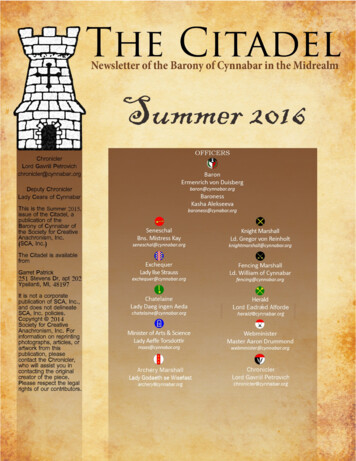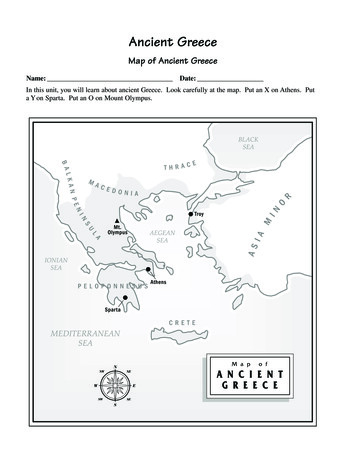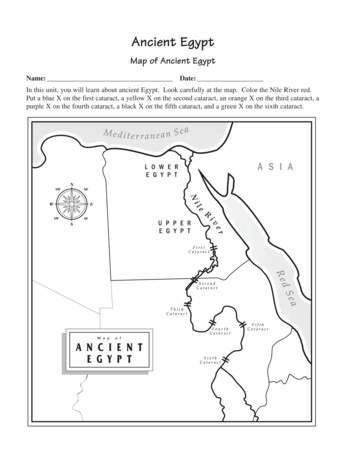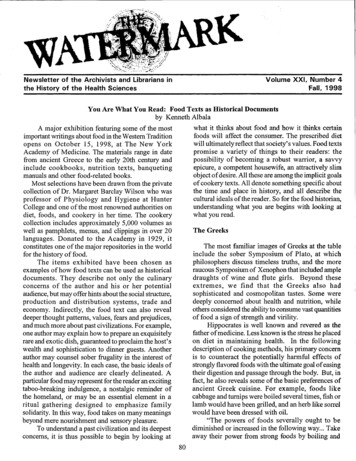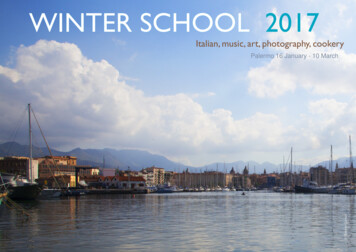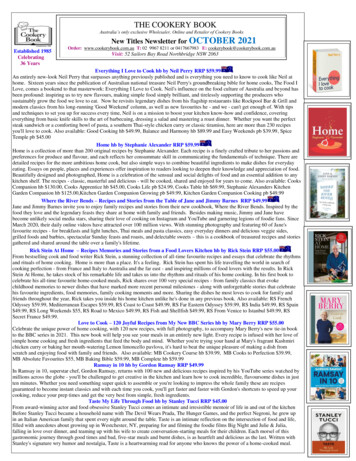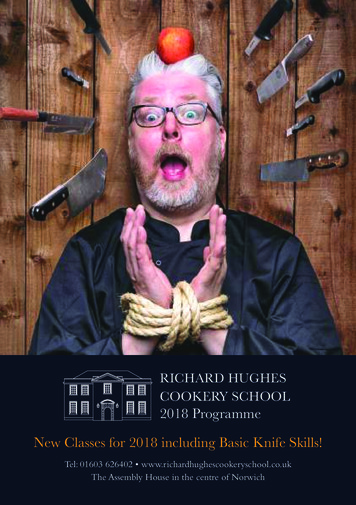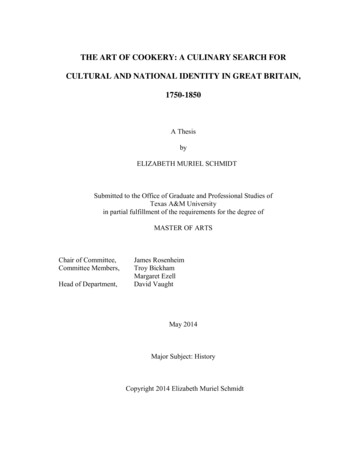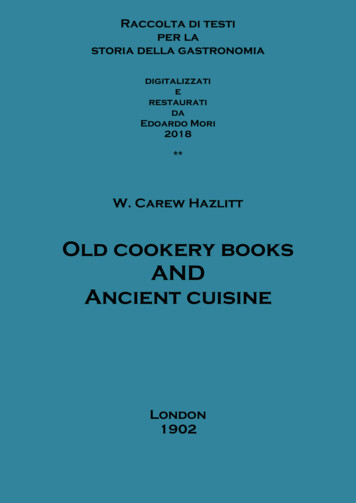
Transcription
Raccolta di testiper lastoria della gastronomiadigitalizzatierestauratidaEdoardo Mori2018**W. Carew HazlittOld cookery booksANDAncient cuisineLondon1902
W. CAREW HAZLITTOLD COOKERY BOOKSANDANCIENT CUISINELONDON1902
The text was digitized and transcribed by Edoardo Mori.I enclose the text also in docx format to allow furthercorrections to the transcriptionThe numbers in square brackets indicate the original text page.
INTRODUCTORY[Pag.1] MAN has been distinguished from other animals in various ways;but perhaps there is no particular in which he exhibits so marked a differencefrom the rest of creation — not even in the prehensile faculty resident in hishand — as in the objection to raw food, meat, and vegetables. Heapproximates to his inferior contemporaries only in the matter of fruit,salads, and oysters, not to mention wild-duck. He entertains no sympathywith the cannibal, who judges the flavor of his enemy improved bytemporary commitment to a subterranean larder; yet, to be sure, he keeps hisgrouse and his venison till it approaches the condition of spoon-meat.It naturally ensues, from the absence or scantiness of explicit orsystematic information connected with the opening stages of such inquiriesas the present, that the student is compelled to draw his own inferences fromindirect or unwitting allusion; but so long as conjecture and hypothesis arenot too freely indulged, this class of evidence is, as a rule, tolerablytrustworthy, and is, moreover, open to verification.When we pass from an examination of the state of the question asregarded Cookery in very early times among us, before an even morevaluable art — that of Printing — was discovered, we shall find ourselvesface to face with a rich and long chronological series of books on theMystery, the titles and forefronts of which are often not without a kind offragrance and gout.As the space allotted to me is limited, and as the sketch left by Warner ofthe convivial habits and household arrangements of the Saxons or Normansin this island, as well as of the monastic institutions, is more copious thanany which I could offer, it may be best to refer simply to his elaboratepreface. But it may be pointed out generally that the establishment of theNorman sway not only purged of some of their Anglo-Danish barbarism thetables of the nobility and the higher classes, but did much to spread amongthe poor a thriftier manipulation of the articles of food by a resort to broths,messes, and hotpots. In the poorer districts, in Normandy as well as inBrittany, Duke William would probably find very little alteration in themode of preparing victuals from that which was in use in his day, eighthundred years ago, if (like another Arthur) he should return among his
ancient compatriots; but in his adopted country he would see that there hadbeen a considerable revolt from the common saucepan — not to add from thepseudo Arthurian bag-pudding 3 and that the English artisan, if he could geta rump-steak or a leg of mutton once a week, was content to starve on theother six days.Those who desire to be more amply informed of the domestic economy ofthe ancient court, and to study the minutia, into which I am precluded fromentering, can easily gratify themselves in the pages of “ The Ordinances andRegulations for the Government of the Royal Household,” 1790; “TheNorthumberland Household Book f and the various printed volumes of “Privy Purse Expenses ” of royal and great personages, including “TheHousehold Roll of Bishop Swinfield (1289-90).”The late Mr. Green, in his “ History of the English People” (1880-3, 4vols. 8vo), does not seem to have concerned himself about the kitchens orgardens of the nation which he undertook to describe. Yet, what conspicuouselements these have been in our social and domestic progress, and whatcivilising factors !To a proper and accurate appreciation of the cookery of ancient timesamong ourselves, a knowledge of its condition in other more or lessneighbouring countries, and of the surrounding influences and conditionswhich marked the dawn of the art in England, and its slow transition to aluxurious excess, would be in strictness necessary; but I am tempted to referthe reader to an admirable series of papers which appeared on this subject inParker’s “ Domestic Architecture,” and were collected in 1861, under thetitle of “ Our English Home: its Early History and Progress.” In this littlevolume the author, who does not give his name, has drawn together in asuccinct compass the collateral information which will help to render thefollowing pages more luminous and interesting. An essay might be writtenon the appointments of the table only, their introduction, development, andmultiplication.The history and antiquities of the Culinary Art among the Greeks arehandled with his usual care and skill by M. J. A. St. John in his “Manners andCustoms of Ancient Greece,” 1842 ; and in the Biblia or Hebrew Scriptureswe get an indirect insight into the method of cooking from the forms ofsacrifice.The earliest legend which remains to us of Hellenic gastronomy isassociated with cannibalism. It is the story of Pelops — an episode almostpre-Homeric, where a certain rudimentary knowledge of dressing flesh, andeven of disguising its real nature, is implied in the tale, as it descends to us;
and the next in order of times is perhaps the familiar passage in the Odyssey,recounting the adventures of Odysseus and his companions in the cave ofPolyphemus. Here, again, we are introduced to a rude society ofcave-dwellers, who eat human flesh, if not as an habitual diet, yet not onlywithout reluctance, but with relish and enjoyment.The Phagetica of Ennius, of which fragments remain, seems to be themost ancient treatise of the kind in Roman literature. It is supposed to relatean account of edible fishes; but in a complete state the work may very wellhave amounted to a general Manual on the subject. In relation even toHomer, the Phagetica is comparatively modem, following the Odyssey at adistance of some six centuries; and in the interval it is extremely likely thatanthropophagy had become rarer among the Greeks, and that if they stillcontinued to be cooking animals, they were relinquishing the practice ofcooking one another.Mr. Ferguson, again, has built on Athenseus and other authorities a highlyvaluable paper on “ The Formation of the Palate,” and the late Mr. Coote, inthe forty-first volume of “ Archaelogia," has a second on the “ CuisineBourgeoise” of ancient Rome. These two essays, with the “ FairfaxInventories ” communicated to the forty-eighth volume of the “Archaelogia" by Mr. Peacock, cover much of the ground which had been scarcelytraversed before by any scientific English inquirer. The importance of aninsight into the culinary economy of the Romans lies in the obligations underwhich the more western nations of Europe are to it for nearly all that they atfirst knew upon the subject. The Romans, on their part, were borrowers inthis, as in other, sciences from Greece, where the arts of cookery andmedicine were associated, and were studied by physicians of the greatesteminence; and to Greece these mysteries found their way from Orientalsources. But the school of cookery which the Romans introduced into Britainwas gradually superseded in large measure by one more agreeable to theclimate and physical demands of the people; and the free use of animal food,which was probably never a leading feature in the diet of the Italians as acommunity, and may be treated as an incidence of imperial luxury, provednot merely innocuous, but actually beneficial to a more northerly race.So little is to be collected — in the shape of direct testimony, next tonothing — of the domestic life of the Britons — that it is only by conjecturethat one arrives at the conclusion that the original diet of our countrymenconsisted of vegetables, wild fruit, the honey of wild bees — which is stillextensively used in this country, a coarse sort of bread, and milk. The latterwas evidently treated as a very precious article of consumption, and its value
was enhanced by the absence of oil and the apparent want of butter. Mr.Ferguson supposes, from some remains of newly-born calves, that ourancestors sacrificed the young of the cow rather than submit to a loss of themilk; but it was, on the contrary, an early superstition, and may be, onobvious grounds, a fact, that the presence of the young increased the yield inthe mother, and that the removal of the calf was detrimental. The Italianinvaders augmented and enriched the fare, without, perhaps, materiallyaltering its character; and the first decided reformation in the mode of livinghere was doubtless achieved by the Saxon and Danish settlers; for those inthe south, who had migrated hither from the Low Countries, ate little flesh,and indeed, as to certain animals, cherished, according to Caesar, religiousscruples against it.It was to the hunting tribes, who came to us from regions even bleaker andmore exacting than our own, that the southern counties owed the taste forvenison and a call for some nourishment more sustaining than farinaceoussubstances, green stuff and milk, as well as a gradual dissipation of theprejudice against the hare, the goose, and the hen as articles of food, whichthe “ Commentaries ” record. It is characteristic of the nature of ournationality, however, that while the Anglo-Saxons and their successorsrefused to confine themselves to the fare which was more or less adequate tothe purposes of archaic pastoral life in this island, they by no meansrenounced their partiality for farm and garden produce, but by a fusion ofculinary tastes and experiences akin to fusion of race and blood, laid thebasis of the splendid cuisine of the Plantagenet and Tudor periods. Ourcookery is, like our tongue, an amalgam.But the Roman historian saw little or nothing of our country except thoseportions which lay along or near the southern coast; the rest of his narrativewas founded on hearsay; and he admits that the people in the interior —those beyond the range of his personal knowledge, more particularly thenorthern tribes and the Scots — were flesh-eaters, by which he probablyintends, not consumers of cattle, but of the venison, game, and fish whichabounded in their forests and rivers. The various parts of this country were inCaesar’s day, and very long after, more distinct from each other for allpurposes of communication and intercourse than we are now from Spain orfrom Switzerland; and the foreign influences which affected the SouthBritons made no mark on those petty states which lay at a distance, andwhose diet was governed by purely local conditions. The dwellers northwardwere by nature hunters and fishermen, and became only by Act of Parliamentpoachers, smugglers, and illicit distillers; the province of the male portion of
the family was to find food for the rest; and a pair of spurs laid on an emptytrencher was well understood by the goodman as a token that the larder wasempty and replenishable.There are new books on all subjects, of which it is comparatively easywithin a moderate compass to afford an intelligible, perhaps even asufficient, account. But there are others which I, for my part, hesitate totouch, and which do not seem to be amenable to the law of selection.“Studies in Nidderland,” by Mr. Joseph Lucas, is one of these. It was alabour of love, and it is full ot records of singular survivals to our time otarchaisms of all descriptions, culinary and gardening utensils not forgotten.There is one point, which I may perhaps advert to, and it is the square ofwood with a handle, which the folk in that part of Yorkshire employed, inlieu of the ladle, for stirring, and the stone ovens for baking, which, theauthor tells us, occur also in a part of Surrey. But the volume should be readas a whole. We have of such too few.Under the name of a Roman epicure, Coelius Apicius, has come down tous what may be accepted as the most ancient European “ Book of Cookery.”I think that the idea widely entertained as to this work having proceededfrom the pen of a man, after whom it was christened, has no more substantialbasis than a theory would have that the “ Arabian Nights ” were composedby Haroun al Raschid. Warner, in the introduction to his “AntiquitatesCulinaria,” 1791, adduces as a specimen of the rest two receipts from thiscollection, shewing how the Roman cook of the Apician epoch was wont todress a hog’s paunch, and to manufacture sauce for a boiled chicken. Of thethree persons who bore the name, it seems to be thought most likely that theone who lived under Trajan was the true godfather of the Culinary Manual.One of Massinger's characters (Holdfast) in the “City Madam,” 1658, ismade to charge the gourmets of his time with all the sins of extravaganceperpetrated in their most luxurious and fantastic epoch. The object was toamuse the audience; but in England no “ court gluttony,” much less countryChristmas, ever saw buttered eggs which had cost 30, or pies of carps'tongues, or pheasants drenched with ambergris, or sauce for a peacock madeof the gravy of three fat wethers, or sucking pigs at twenty marks each.Both Apicius and our Joe Miller died within 80,000 of being beggars —Miller something the nigher to that goal; and there was this community ofinsincerity also, that neither really wrote the books which carry their names.Miller could not make a joke or understand one when anybody else made it.His Roman foregoer, who would certainly never have gone for his dinner toClare Market, relished good dishes, even if he could not cook them.
It appears not unlikely that the Romish clergy, whose monastic vowscommitted them to a secluded life, were thus led to seek some compensationfor the loss of other worldly pleasures in those of the table; and that, whenone considers the luxury of the old .abbeys, one ought to recollect at thesame time, that it was perhaps in this case as it was in regard to letters and thearts, and that we are under a certain amount of obligation to the monks formodifying the barbarism of the table, and encouraging a study ofgastronomy.There are more ways to fame than even Horace suspected. The road toimmortality is not one but manifold. A man can but do what he can. As thepoet writes and the painter fills with his inspiration the mute and voidcanvas, so doth the Cook his part. There was formerly apopular work inFrance entitled “ Le Cuisinier Royal,” by MM. Viard and Fouret, whodescribe themselves as “ Hommes de Bouche.” The twelfth edition liesbefore me, a thick octavo volume, dated 1805. The title-page is succeeded byan anonymous address to the reader, at the foot of which occurs aperemptory warning to pilferers of dishes or parts thereof; in other words, topiratical invaders of the copyright of Monsieur Barba. There is a prefaceequally unclaimed by signatures or initials, but as it is in the singular numberthe two hommes de bouche can scarcely have written it; perchance it was M.Barba aforesaid, lord-proprietor of these not-to-be-touched treasures ; butanyhow the writer had a very solemn feeling of the debt which he hadconferred on society by making the contents public for the twelfth time, andhe concludes with a mixture of sentiments, which it is very difficult to define: “ Dans la paix de ma conscience, non moins que dans l’orgueil d’avoir sihonorablement rempli cette importante mission, je m’ecrierai avec le poetedes gourmands et des amoureux :Exegi monumentum aere perenniusNon omnis moriar.
THE EARLY ENGLISHMAN ANDHIS FOOD.[Pag.16] WILLIAM OF MALMESBURY particularly dwells on thebroad line of distinction still existing between the southern English and thefolk of the more northerly districts in his day, twelve hundred years after thevisit of Caesar. He says that they were then (about A.D. 1150) as different asif they had been different races; and so in fact they were — different in theirorigin, in their language, and their diet.In his “Folk-lore Relics of Early Village Life,” 1883, Mr. Gommedevotes a chapter to “Early Domestic Customs,” and quotes Henry’s“History of Great Britain” for a highly curious clue to the primitive mode ofdressing food, and partaking of it, among the Britons. Among theAnglo-Saxons the choice of poultry and game was fairly wide. AlexanderNeckam, in his “ Treatise on Utensils (twelfth century)” gives fowls, cocks,peacocks, the cock of the wood (the woodcock, not the capercailzie),thrushes, pheasants, and several more; and pigeons were only too plentiful.The hare and the rabbit were well enough known, and with the leveret formpart of an enumeration of wild animals (animalium ferarum) in a pictorialvocabulary of the fifteenth century. But in the very early accounts or lists,although they must have soon been brought into requisition, they are notspecifically cited as current dishes. How far this is attributable to the allegedrepugnance of the Britons to use the hare for the table, as Caesar apprises usthat they kept it only volupiatis causa, it is hard to say; but the way in whichthe author of the “Commentaries” puts it induces the persuasion that by lepushe means not the hare, but the rabbit, as the former would scarcely bedomesticated.Neckam gives very minute directions for the preparation of pork for thetable. He appears to have considered that broiling on the grill was the bestway; the gridiron had supplanted the hot stones or bricks in more fashionablehouseholds, and he recommends a brisk fire, perhaps with an eye to theskilful development of the crackling. He died without the happiness ofbringing his archiepiscopal nostrils in contact with the sage and onions ofwiser generations, and thinks that a little salt is enough. But, as we havebefore explained, Neckam prescribed for great folks. These refinements
were unknown beyond the precincts of the palace and the castle.In the ancient cookery-book, the “Menagier de Paris,” 1393, which offersnumerous points of similarity to our native culinary lore, the resources of thecuisine are represented as amplified by receipts for dressing hedgehogs,squirrels, magpies, and jackdaws — small deer, which the English expertsdid not affect, although I believe that the hedgehog is frequently used to thisday by country folk, both here and abroad, and in India. It has white,rabbit-like flesh.In an eleventh century vocabulary we meet with a tolerably rich variety offish, of which the consumption was relatively larger in former times. TheSaxons fished both with the basket and the net. Among the fish hereenumerated are the whale (which was largely used for food), the dolphin,porpoise, crab, oyster, herring, cockle, smelt, and eel. But in the supplementto Alfric’s vocabulary, and in another belonging to the same epoch, there areimportant additions to this list: the salmon, the trout, the lobster, the bleak,with the whelk and other shell-fish. But we do not notice the turbot, sole, andmany other varieties, which became familiar in the next generation or so.The turbot and sole are indeed included in the “Treatise on Utensils” ofNeckam, as are likewise the lamprey (of which King John is said to havebeen very fond), bleak, gudgeon, conger, plaice, limpet, ray, and mackerel.The fifteenth century, if I may judge from a vocabulary of that date inWright’s collection, acquired a much larger choice of fish, and some of thenames approximate more nearly to those in modern use. We meet with thesturgeon, the whiting, the roach, the miller’s thumb, the thomback, thecodling, the perch, the gudgeon, the turbot, the pike, the tench, and thehaddock. It is worth noticing also that a distinction was now drawn betweenthe fisherman and the fishmonger — the man who caught the fish and hewho sold it — piscator and ptscarius ; and in the vocabulary itself theleonine line is cited: “ Piscator prendit, quod piscarius bene vendit.”The whale was considerably brought into requisition for gastronomicpurposes. It was found on the royal table, as well as on that of the LordMayor of London. The cook either roasted it, and served it up on the spit, orboiled it and sent it in with peas; the tongue and the tail were favourite parts.The porpoise, however, was brought into the hall whole, and was cawedor undertranched by the officer in attendance. It was eaten with mustard.The pièce de résistance at a banquet which Wolsey gave to some of hisofficial acquaintances in 1509, was a young porpoise, which had cost eightshillings; it was on the same occasion that His Eminence partook ofstrawberries and cream, perhaps; he is reported to have been the person who
made that pleasant combination fashionable.The grampus, or sea-wolf, was another article of food which bearstestimony to the coarse palate of the early Englishman, and at the same timemay afford a clue to the partiality for disguising condiments and spices. Butit appears from an entry in his Privy Purse Expenses, under September 8,1498, that Henry the Seventh thought a porpoise a valuable commodity and afit dish for an ambassador, for on that date twenty-one shillings were paid toCardinal Morton’s servant, who had procured one for some envoy then inLondon, perhaps the French representative, who is the recipient of acomplimentary gratuity of 49 10s. on April 12, 1499, at his departure fromEngland. In the fifteenth century the existing stock of fish for culinarypurposes received, if we may trust the vocabularies, a few accessions ; as, forinstance, the bream, the skate, the flounder, and the hake.In “Piers of Fulham (14th century),” we hear of the good store of fat eelsimported into England from the Low Countries, and to be had cheap byanyone who watched the tides; but the author reprehends the growing luxuryof using the livers of young fish before they were large enough to be broughtto the table.The most comprehensive catalogue of fish brought to table in the time ofCharles I. is in a pamphlet of 1644, inserted among my “Fugitive Tracts,”1875; and includes the oyster, which used to be eaten at breakfast with wine,the crab, lobster, sturgeon, salmon, ling, flounder, plaice, whiting, sprat,herring, pike, bream, roach, dace, and eel. The writer states that the sprat andherring were used in Lent. The sound of the stock-fish, boiled in wort or thinale till they were tender, then laid on a cloth and dried, and finally cut intostrips, was thought a good receipt for book-glue.An acquaintance is in possession of an old cookery-book which exhibitsthe gamut of the fish as it lies in the frying-pan, reducing its supposed lamentto musical notation. Here is an ingenious refinement and a delicate piece ofirony, which Walton and Cotton might have liked to forestall.The 15 th century Nominale enriches the catalogue of dishes then invogue. It specifies almond-milk, rice, gruel, fish-broth or soup, a sort offricassee of fowl, collops, a pie, a pasty, a tart, a tartlet, a charlet (mincedpork), apple-juice, a dish called jussell made of eggs and grated bread withseasoning of sage and saffron, and the three generic heads of sod or boiled,roast, and fried meats. In addition to the fish-soup, they had wine-soup,water-soup, ale-soup; and the flawn is reinforced by the froise. Instead ofone Latin equivalent for a pudding, it is of moment to record that there arenow three : nor should we overlook the rasher and the sausage. It is the
earliest place where we get some of our familiar articles of diet-beef, mutton,pork, veal — under their modern names; and about the same time such termspresent themselves as “a broth,” “a browis,” “a pottage,” “a mess.”Of the dishes which have been specified, the froise corresponded to anomelette au lard of modern French cookery, having strips of bacon in it. Thetansy was an omelette of another description, made chiefly with eggs andchopped herbs. As the former was a common dish in the monasteries, it is notimprobable that it was one grateful to the palate. In Lydgate’s “ Story ofThebes,” a sort of sequel to the “ Canterbury Tales,” the pilgrims invite thepoet to join the supper-table, where there were these tasty omelettes: moile,made of marrow and grated bread, and haggis, which is supposed to beidentical with the Scottish dish so called. Lydgate, who belonged to themonastery of Bury St. Edmunds, doubtless set on the table at Canterburysome of the dainties with which he was familiar at home; and this practice,which runs through all romantic and imaginative literature, constitutes, inour appreciation its principal worth. We love and cherish it for its very sinsagainst chronological and topographical fitness — its contempt of all unities.Men transferred local circumstances and a local colouring to their pictures ofdistant countries and manners. They argued the unknown from what theysaw under their own eyes. They portrayed to us what, so far as the scenes andcharacters of their story went, was undeceivingly false, but what on thecontrary, had it not been so, would never have been unveiled respectingthemselves and their time.The expenditure on festive occasions seems, from some of the entries inthe “ Northumberland Household Book” to present a strong contrast to theordinary dietary allowed to the members of a noble and wealthy household,especially on fish days, in the earlier Tudor era (1512). The noontidebreakfast provided for the Percy establishment was of a very modestcharacter: my lord and my lady had for example, a loaf of bread, twomanchets (loaves of finer bread), a quart of beer and one of wine, two piecesof salt fish, and six baked herrings or a dish of sprats. My lord Percy andMaster Thomas Percy had half a loaf of household bread, a manchet, a pottleof beer, a dish of butter, a piece of salt fish, and a dish of sprats or three whiteherrings; and the nursery breakfast for my lady Margaret and Master IngramPercy was much the same. But on flesh days my lord and lady fared better,for they had a loaf of bread, two manchets, a quart of beer and the same ofwine, and half a chine of mutton or boiled beef; while the nursery repastconsisted of a manchet, a quart of beer, and three boiled mutton breasts ; andso on : whence it is deducible that in the Percy family, perhaps in all other
great houses, the members and the ladies and gentlemen in waiting partookof their earliest meal apart in their respective chambers, and met only at sixto dine or sup.The beer, which was an invariable part of the menu, was perhaps brewedfrom hops which, according to Harrison elsewhere quoted, were, after a longdiscontinuance, again coming into use about this time. But it would be alightbodied drink which was allotted to the consumption at all events ofMasters Thomas and Ingram Percy, and even of my Lady Margaret.It is clearly not irrelevant to my object to correct the general impressionthat the great families continued throughout the year to support the strainwhich the system of keeping open house must have involved. For, as Warnerhas stated, there were intervals during which the aristocracy permittedthemselves to unbend, and shook off the trammels imposed on them by theirsocial rank and responsibility. This was known as “ keeping secret house,”or, in other words, my lord became for a season incognito, and retired to oneof his remoter properties for relaxation and repose. Our kings in somemeasure did the same; for they held their revels only, as a rule, at stated timesand places. William I. is said to have kept his Easter at Winchester, hisWhitsuntide at Westminster, and his Christmas at Gloucester. Even theseantique grandees had to work on some plan. It could not be all mirth andjollity. A recital of some of the articles on sale in a baker's or confectioner’sshop in 1563, occurs in Newbery’s “Dives Pragmaticus”: simnels, buns,cakes, biscuits, comfits, caraways, and cracknels: and this is the firstoccurrence of the bun that I have hitherto been able to detect. The same tractsupplies us with a few other items germane to my subject: figs, almonds,long pepper, dates, prunes, and nutmegs. It is curious to watch how bydegrees the kitchen department was furnished with articles which nowadaysare viewed as the commonest necessaries of life.In the 17 th century the increased communication with the Continentmade us by degrees larger partakers of the discoveries of foreign cooks.Noblemen and gentlemen travelling abroad brought back with them receiptsfor making the dishes which they had tasted in the course of their tours. Inthe “ Compleat Cook,” 1655 and 1662, the beneficial operation of actualexperience of this kind, and of the introduction of such books as the“Receipts for Dutch Victual” and “Epulario, or the Italian Banquet," toEnglish readersand students, is manifest enough; for in the latter volume weget such entries as these: “To make a Portugal dish;” “ To make a Virginiadish;” A Persian dish “ A Spanish olio;” and then there are receipts “To makea Posset the Earl of Arundel’s way;” “To make the Lady Abergavenny’s
Cheese;” “The Jacobin’s Pottage; To make Mrs. Leeds’ Cheesecakes;” “TheLord Conway His Lordship’s receipt for the making of Amber Puddings;”“The Countess of Rutland’s receipt of making the Rare Banbury Cake,which was so much praised as her daughter’s (the Right Honourable LadyChaworth) Pudding,” and “ To make Poor Knights” — the last a medley inwhich bread, cream, and eggs were the leading materials.Warner, however, in the “Additional Notes and Observations ” to his “Antiquitates Culinariae,” 1791, expresses himself adversely to the foreignsystems of cookery from an English point of view. “Notwithstanding” eremarks, “ the partiality of our countrymen to French cookery, yet that modeof disguising meat m this kingdom (except perhaps in the hottest part of thehottest season of the year) is an absurdity. It is here the art of spoiling goodmeat. The same art, indeed, in the South of France, where the climate ismuch warmer, and the flesh of the animal lean and i
OLD COOKERY BOOKS AND ANCIENT CUISINE LONDON 1902 . The text was digitized and transcribed by Edoardo Mori. . The Italian invaders augmented and enriched the fare, without, perhaps, materially altering its character; and the first decided reformation in the mode of living

